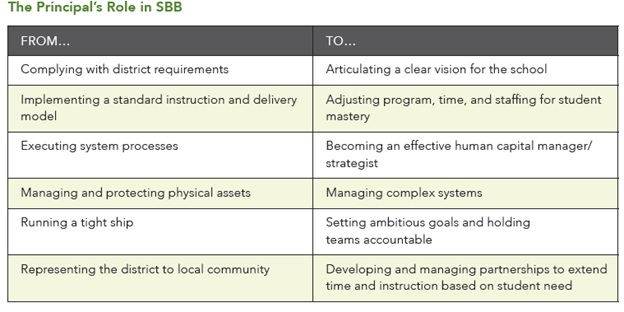A primary concern when school district officials and state policymakers are considering shifting to student-based budgeting is whether or not principals have the time and skills needed to control and manage their school budgets. Quite often, this fear stems from a misconception about the relationship between student-based budgeting and instructional leadership, as well as fixed mindsets related to overly rigid implementation (i.e. it must be done and look a certain way).
Adopting student-based budgeting (SBB), however, does not mean that principals must become Excel spreadsheet whizzes and learn the intricacies of cost-based accounting. Rather, when implemented effectively, SBB empowers principals to fully align their schools resources and strategic priorities without significant technical expertise. This is especially important given the significant impact that principals have on school outcomes. Research has shown that effective principals can raise a student’s achievement level by between two and seven months of learning in just one academic year. And student-based budgeting can help principals maximize this impact.
Student-Based Budgeting and the Principal’s Role as Instructional Leader
Undoubtedly, the transition to SBB can be complex and the nature of a principal’s role evolves with this change. Education Resource Strategies (ERS) provides a useful snapshot of this evolution below.
In short, a principal must go from a highly-centralized environment where many key decisions are made at the district level to one in which they’re leading more robust strategic planning processes at their owns schools. According to ERS, which has helped numerous districts transition to student-based budgeting, SBB is most impactful when it seamlessly integrates equitable funding, principal autonomy, and Strategic School Design.
Strategic School Design (SSD) is a planning framework in which school leaders are “lead designers” in determining how resources are allocated. School leaders begin the process by identifying key needs and creating a vision that addresses them. This vision is then used to create a resource-allocation plan according to three primary principles: excellent teachers for all students, personalized learning and support, and cost-effectiveness through creative solutions.
In this process a principal’s role as an instructional leader is enhanced because strategic-school design engages campus leaders and teachers in more meaningful planning. Furthermore, the flexibility provided to schools and teachers offers them the opportunity to devise innovative solutions that might not be possible in a top-down budget coming from the district office.
In student-based budgeting, school-level priorities drive budgeting and not the other way around.
Understandably, some fear budgetary responsibilities might pull a principal away from their most critical responsibilities overseeing the education of a school’s students. In reality, however, SBB serves to immerse principals more deeply in what is working and what is needed at their schools. Quite simply, SBB is a means toward more robust instructional leadership. Without budgetary autonomy, principals are not fully empowered to create and implement their academic strategies.
Student-Based Budgeting Implementation
More than 30 districts have either already implemented or are piloting student-based budgeting. While there are many similarities among these systems, SBB is not a one-size-fits-all policy. District leaders must adapt it to the unique needs of their schools and account for factors such as personnel and compliance.
A critical component of SBB implementation is deciding how to transition budget autonomy to school principals. While the ultimate goal should be to grant every principal autonomy over their resources, some school districts opt to use earned autonomy (i.e. autonomy given to high-performing campuses only) or tiered autonomy (i.e. levels of autonomy based on outcomes, principal capacity, etc.).
Similarly, each district is unique in terms of what decision-making authority remains at the district-level and what is handed over to schools. For example, district officials might decide to retain purchasing authority in some areas in order to achieve economies of scale. Naturally, such decisions have tradeoffs that leaders must weigh.
Additionally, principal training and support are key components of SBB implementation. Approaches have varied among districts and have included principal academies, dedicated coaches, and peer support networks. External stakeholders, such as universities and non-profits, have also proven to be valuable partners in the skill-building process.
Fortunately, many principals already have a solid foundation of skills to work with. According to research conducted by the Wallace Foundation, one of the five pivotal practices that shape instructional leadership is managing people, data, and processes-all core skills involved in SBB. The report finds, “At a time when federal and state accountability mandates have made data analysis a fact of school life, effective principals also know how to make the best use of data.” Developing an understanding of basic budgeting concepts is not a far leap from analyzing student achievement data.
District leaders play a key role in supporting principals throughout the implementation process and are involved in key areas such as creating useful tools and selecting user-friendly budgeting software.
Denver Public Schools, for example, provides every school with a dedicated financial partner who is primarily responsible for providing support to a cohort of school principals. They meet with each principal monthly and provide additional guidance during the budgeting process. Newark Public Schools use the real-time finance software MyBudget, which negates the need for spreadsheets and empowers principals to be autonomous.
Conclusion
Transitioning to student-based budget requires a tremendous amount of work and dedication. Student-based budgeting is not a one-size-fits-all policy and district leaders must ensure that principals are adequately prepared to meet the demands of new challenges. On the surface, it is easy to think transitioning to SBB will pull principals away from their most impactful responsibilities. In reality, however, SBB serves to immerse them more deeply in their role as instructional leaders. Principals in private schools, charter schools, and more than 30 districts are already doing it. And the evidence is clear: 87 percent of public school principals who have transitioned to student-based budgeting want to keep it.
Aaron Garth Smith is an education policy analyst at Reason Foundation.


